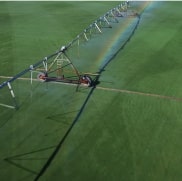Enjoy a luscious, healthy lawn by taking the necessary care and maintenance steps this spring. As we transition from winter to spring, your lawn is emerging from its dormant state and entering a period of growth.
Get your lawn in top shape with this guide from the Lurvey team, which includes helpful tips for spring care, maximizing its beauty and health, choosing the proper fertilizer, practical application tips, and much more!
Understanding Your Lawn’s Spring Needs
With cold temperatures and a lack of sunlight during the winter, your lawn may have experienced slow or stagnant growth. During this period of dormancy, your grass may appear lifeless, but come spring, it will be ready for beautiful spring growth.
Spring Lawn Care Tips: Maximizing Health & Beauty
Transform your lawn this spring by starting your lawn care regimen early and giving it the fertilizer it needs to thrive. Begin by assessing the current state of your lawn, then work to replenish its nutrients and balance pH levels. Make sure to choose the right grass seed for the region and lawn condition, repair bare spots, and de-weed where needed.
Follow the steps below to ensure your lawn is healthy and lush throughout spring. Plus, check out Lurvey’s helpful resources, which provide detailed tips for fertilizing and maintaining your lawn here!
Early Spring Assessment and Cleanup

Grass lawn care in spring starts by evaluating the lawn’s health, removing debris, and assessing winter damage. It is crucial to clear your lawn for adequate nutrient absorption. The first step is raking the lawn for leaves, debris, and thatch. Compacted soil can benefit from aeration, allowing air, water, and nutrients to reach the roots, resulting in stronger and healthier grass.
Before you begin the cleanup process, assess the tools you might need to complete your project. Some of these tools may include a rake for removing leaves and thatch, like a strong aluminum landscape rake, or the Leonard Poly lawn rake that allows you to cover more ground in less time. A wheelbarrow to remove debris from your yard or a shovel to remove any unwanted weeds, stumps, and more.
Soil Testing and Amendment

A soil test will help you determine what nutrients your soil needs and its pH level. Besides pH level, a soil test will also help you identify the ideal level of nitrogen (N), phosphorus (P), and potassium (K) to add to your lawn. You can then make amendments and add the proper fertilizer to promote optimal grass growth based on your soil test.
Crabgrass Prevention and Early Weed Control
Take appropriate steps to prevent common lawn weeds such as crabgrass, chickweed, and poa annua from germinating. Applying a pre-emergent herbicide in early spring can prevent weeds such as crabgrass from taking over your lawn. Timing is vital for successfully controlling weeds.
Fertilizing for Growth
Select an appropriate spring lawn fertilizer to give your soil the minerals and nutrients it needs. Apply your first fertilizer application in early spring. A slow-release formula is best for steady growth without overwhelming new grass.
Overseeding and Repairing Bare Spots
If your lawn has bare spots, it will need seeding. Or if the grass is thin, you may want to thicken it by overseeding. Be sure to choose the right grass seed based on the region and condition of your lawn. For instance, the type of grass and the amount of sun and shade the area receives will determine the required grass seed.
Proper Watering Techniques
To encourage profound root growth, we recommend watering deeply but infrequently. Generally, your lawn needs 1½ to 2 inches of water every week, and each section should be watered twice a week for about 35 to 40 minutes.
Mowing with Care
The best practices for mowing in spring to promote healthy growth include initially mowing the lawn every two weeks. Once it starts growing faster, then weekly mows will suffice. Mow your grass so it’s 3 inches tall; this height will help you develop and maintain a robust and healthy lawn.

Monitoring and Maintenance
Consistent monitoring for pests and diseases is essential for maintaining a healthy lawn. If you notice weeds, diseases, or an abundance of insects, spraying may be necessary.
Choosing the Right Fertilizer
At Lurvey, we offer a range of effective and beneficial fertilizer products to help you save time and money while maintaining a healthy lawn. Discover our wide selection of premium fertilizers, including ornamental fertilizers, available as water soluble, time-released, and more.
At Lurvey, we highly recommend utilizing a top-notch, gradual-release nitrogen source. By adopting a lower input fertilization approach and cutting back nitrogen rates to below 3 pounds annually, you’ll see impressive results that are both eco-friendly and cost-effective. Discover our wide selection of residential turf fertilizers from top-quality brands such as Espoma, Milorganite, Miracle-Gro, Spring Valley, Jonathan Green, and The Andersons Group.
Practical Tips for Application
After analyzing your soil test results, you can select the most suitable fertilizer for your lawn. Begin fertilizing your lawn using a broadcast or rotary spreader, which will help evenly distribute the fertilizer, avoiding burns and pale areas. After applying the fertilizer, make sure to water the lawn thoroughly. Lurvey’s Chapin spreader is perfect for getting the job done.
Cultivating Excellence in Your Spring Lawn Care Journey

Spring lawn care starts with Lurvey’s high-quality, effective fertilizer products. We are proud to be one of the top Landscape Distribution Centers in the country, providing premium plant and hardscape materials. Whether you’re looking to repair bare spots in your lawn or regulate your soil after winter, we are here to assist you in achieving a lush lawn! If you’re new to gardening or need some additional tips on how to measure the sod, or the right lawn fertilization, please refer to our additional guides on specific products. Contact us today to get started!










